Computerised Accounting in SAP: Benefits, History, and Migration
VerifiedAdded on 2023/06/05
|14
|4396
|463
AI Summary
This report explores the benefits, history, and migration process of SAP S/4HANA for computerised accounting. It covers the importance of ERP, the history of SAP S/4HANA, the difference between SAP S/4HANA Finance and SAP ERP FICO, and the benefits of using SAP S/4HANA for business. It also discusses the migration process to SAP S/4HANA and the challenges that come with it.
Contribute Materials
Your contribution can guide someone’s learning journey. Share your
documents today.
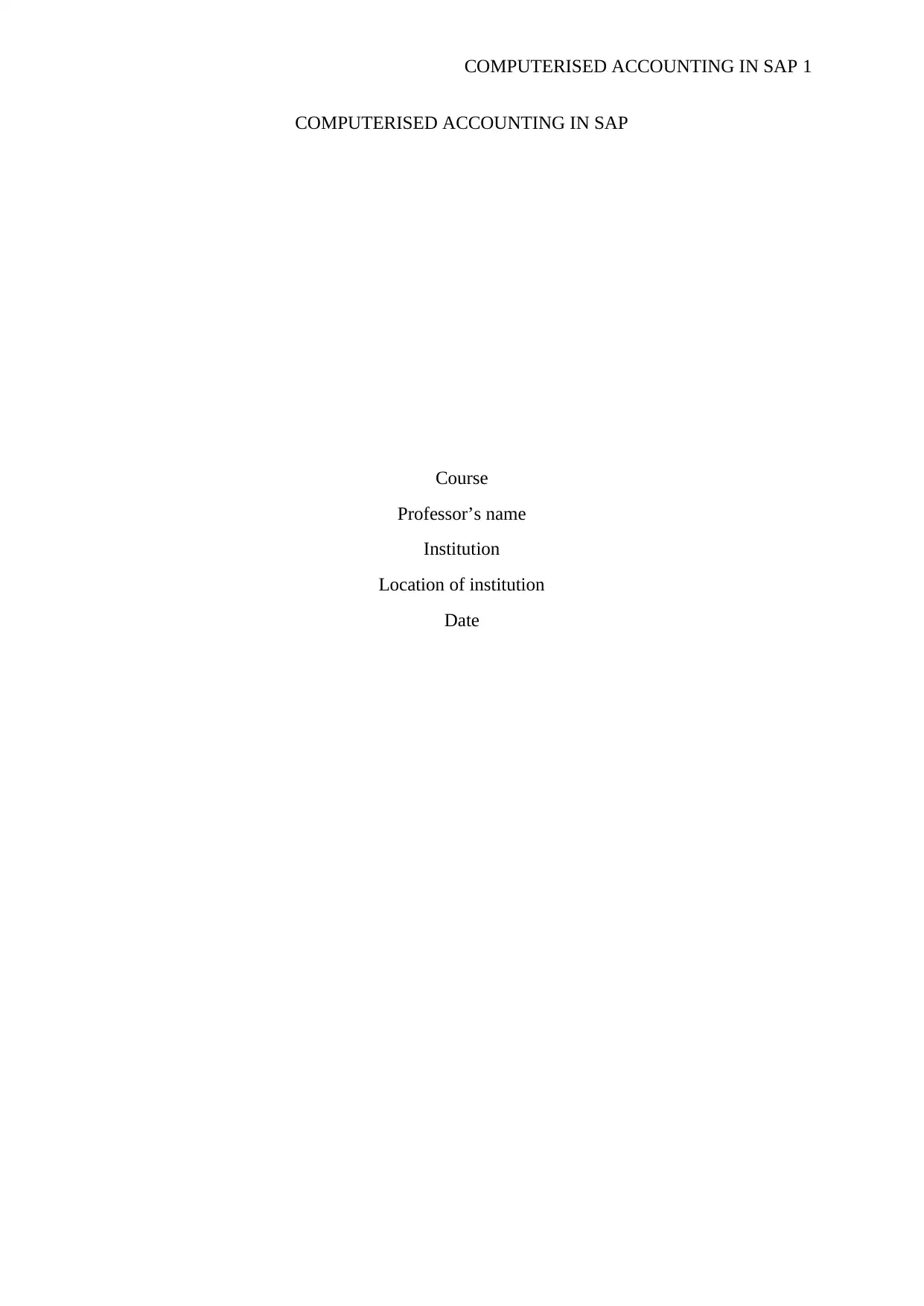
COMPUTERISED ACCOUNTING IN SAP 1
COMPUTERISED ACCOUNTING IN SAP
Course
Professor’s name
Institution
Location of institution
Date
COMPUTERISED ACCOUNTING IN SAP
Course
Professor’s name
Institution
Location of institution
Date
Secure Best Marks with AI Grader
Need help grading? Try our AI Grader for instant feedback on your assignments.

COMPUTERISED ACCOUNTING IN SAP 2
Computerized accounting in SAP
Introduction
Computerized accounting is one of the fundamental areas that is invested highly in the
business organization. Companies nowadays employ the use of Enterprise Resource Planning
(ERP) to analyse and store all financial data. ERP has helped in faster analysis and generation
of financial reports. This report on SAP S/4HANA outlines the importance and challenges of
SAP software on business, user experience in using SAP software, whether it is user-friendly
or not is described in the report. The companies using SAP software have considerable
experience in providing real-time reports and global regulatory and compliance abilities
across all languages. ERP software has helped the firms in closing monthly reports. The SAP
software has brought a lot of changes in the business environments, and provide an added
advantage on business firms over their competitors. This report on SAP S/4HANA contains a
brief history of the software, that is, when and where it was launched and whether it is a
multinational corporation. The companies that have adopted the use of SAP S/4HANA in
doing their daily transactions includes: CenturyLink Telecommunication Company in
Australia, Protective Life Insurance Company in the United States and Lyondellbasell in
Netherland.
History of SAP S/4HANA
SAP S/4HANA is a business suite that was launched in February 2015 by SAP SE
Multinational Corporation in Germany. This software is the fourth generation of SAP
business enterprise resource planning. This software application has promoted the processing
of vast volumes of business information in real time. The ERP system has been made simple
and easy to use in data entry, storage, and processing of large amounts of transactional data.
Computerized accounting in SAP
Introduction
Computerized accounting is one of the fundamental areas that is invested highly in the
business organization. Companies nowadays employ the use of Enterprise Resource Planning
(ERP) to analyse and store all financial data. ERP has helped in faster analysis and generation
of financial reports. This report on SAP S/4HANA outlines the importance and challenges of
SAP software on business, user experience in using SAP software, whether it is user-friendly
or not is described in the report. The companies using SAP software have considerable
experience in providing real-time reports and global regulatory and compliance abilities
across all languages. ERP software has helped the firms in closing monthly reports. The SAP
software has brought a lot of changes in the business environments, and provide an added
advantage on business firms over their competitors. This report on SAP S/4HANA contains a
brief history of the software, that is, when and where it was launched and whether it is a
multinational corporation. The companies that have adopted the use of SAP S/4HANA in
doing their daily transactions includes: CenturyLink Telecommunication Company in
Australia, Protective Life Insurance Company in the United States and Lyondellbasell in
Netherland.
History of SAP S/4HANA
SAP S/4HANA is a business suite that was launched in February 2015 by SAP SE
Multinational Corporation in Germany. This software is the fourth generation of SAP
business enterprise resource planning. This software application has promoted the processing
of vast volumes of business information in real time. The ERP system has been made simple
and easy to use in data entry, storage, and processing of large amounts of transactional data.
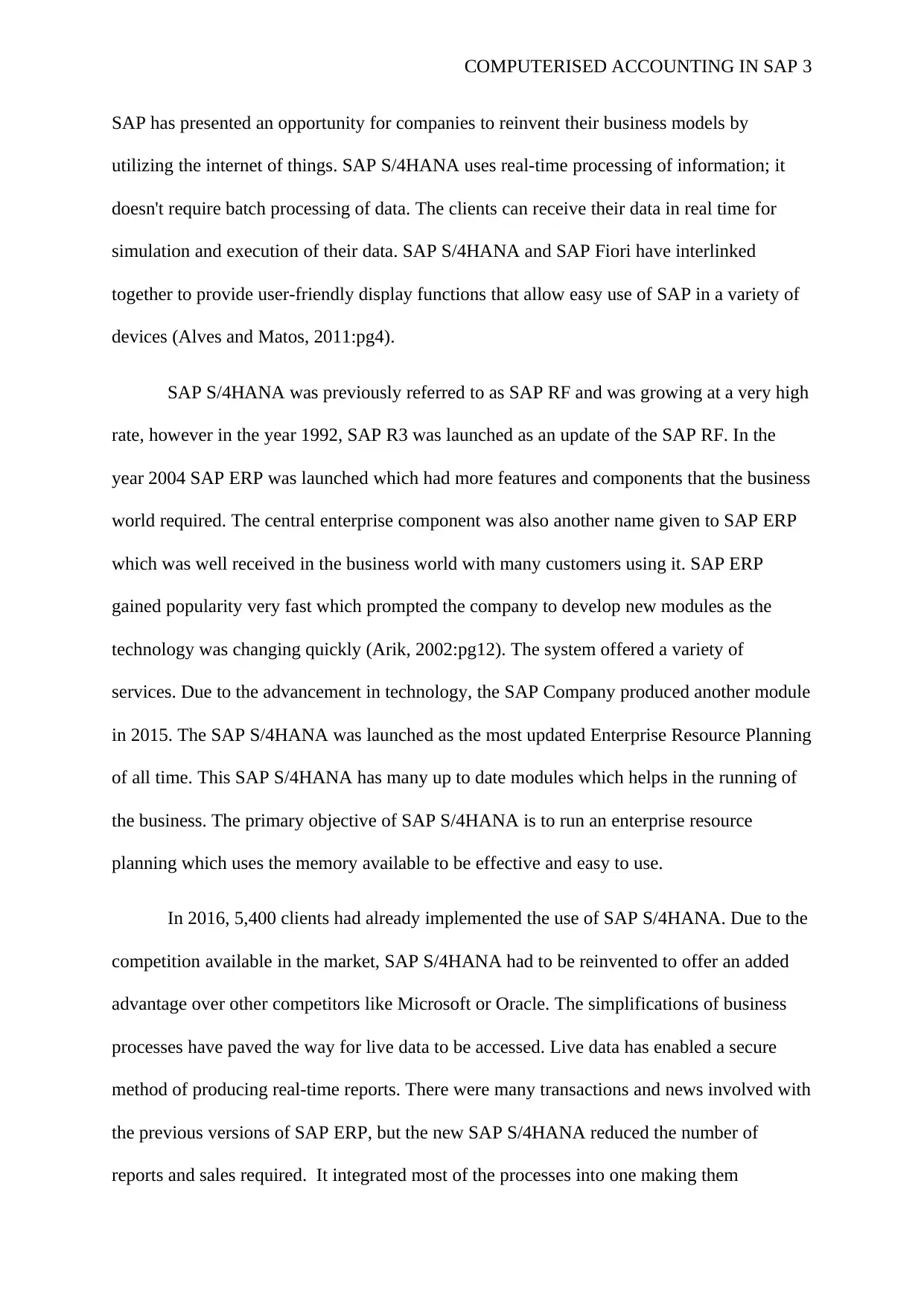
COMPUTERISED ACCOUNTING IN SAP 3
SAP has presented an opportunity for companies to reinvent their business models by
utilizing the internet of things. SAP S/4HANA uses real-time processing of information; it
doesn't require batch processing of data. The clients can receive their data in real time for
simulation and execution of their data. SAP S/4HANA and SAP Fiori have interlinked
together to provide user-friendly display functions that allow easy use of SAP in a variety of
devices (Alves and Matos, 2011:pg4).
SAP S/4HANA was previously referred to as SAP RF and was growing at a very high
rate, however in the year 1992, SAP R3 was launched as an update of the SAP RF. In the
year 2004 SAP ERP was launched which had more features and components that the business
world required. The central enterprise component was also another name given to SAP ERP
which was well received in the business world with many customers using it. SAP ERP
gained popularity very fast which prompted the company to develop new modules as the
technology was changing quickly (Arik, 2002:pg12). The system offered a variety of
services. Due to the advancement in technology, the SAP Company produced another module
in 2015. The SAP S/4HANA was launched as the most updated Enterprise Resource Planning
of all time. This SAP S/4HANA has many up to date modules which helps in the running of
the business. The primary objective of SAP S/4HANA is to run an enterprise resource
planning which uses the memory available to be effective and easy to use.
In 2016, 5,400 clients had already implemented the use of SAP S/4HANA. Due to the
competition available in the market, SAP S/4HANA had to be reinvented to offer an added
advantage over other competitors like Microsoft or Oracle. The simplifications of business
processes have paved the way for live data to be accessed. Live data has enabled a secure
method of producing real-time reports. There were many transactions and news involved with
the previous versions of SAP ERP, but the new SAP S/4HANA reduced the number of
reports and sales required. It integrated most of the processes into one making them
SAP has presented an opportunity for companies to reinvent their business models by
utilizing the internet of things. SAP S/4HANA uses real-time processing of information; it
doesn't require batch processing of data. The clients can receive their data in real time for
simulation and execution of their data. SAP S/4HANA and SAP Fiori have interlinked
together to provide user-friendly display functions that allow easy use of SAP in a variety of
devices (Alves and Matos, 2011:pg4).
SAP S/4HANA was previously referred to as SAP RF and was growing at a very high
rate, however in the year 1992, SAP R3 was launched as an update of the SAP RF. In the
year 2004 SAP ERP was launched which had more features and components that the business
world required. The central enterprise component was also another name given to SAP ERP
which was well received in the business world with many customers using it. SAP ERP
gained popularity very fast which prompted the company to develop new modules as the
technology was changing quickly (Arik, 2002:pg12). The system offered a variety of
services. Due to the advancement in technology, the SAP Company produced another module
in 2015. The SAP S/4HANA was launched as the most updated Enterprise Resource Planning
of all time. This SAP S/4HANA has many up to date modules which helps in the running of
the business. The primary objective of SAP S/4HANA is to run an enterprise resource
planning which uses the memory available to be effective and easy to use.
In 2016, 5,400 clients had already implemented the use of SAP S/4HANA. Due to the
competition available in the market, SAP S/4HANA had to be reinvented to offer an added
advantage over other competitors like Microsoft or Oracle. The simplifications of business
processes have paved the way for live data to be accessed. Live data has enabled a secure
method of producing real-time reports. There were many transactions and news involved with
the previous versions of SAP ERP, but the new SAP S/4HANA reduced the number of
reports and sales required. It integrated most of the processes into one making them
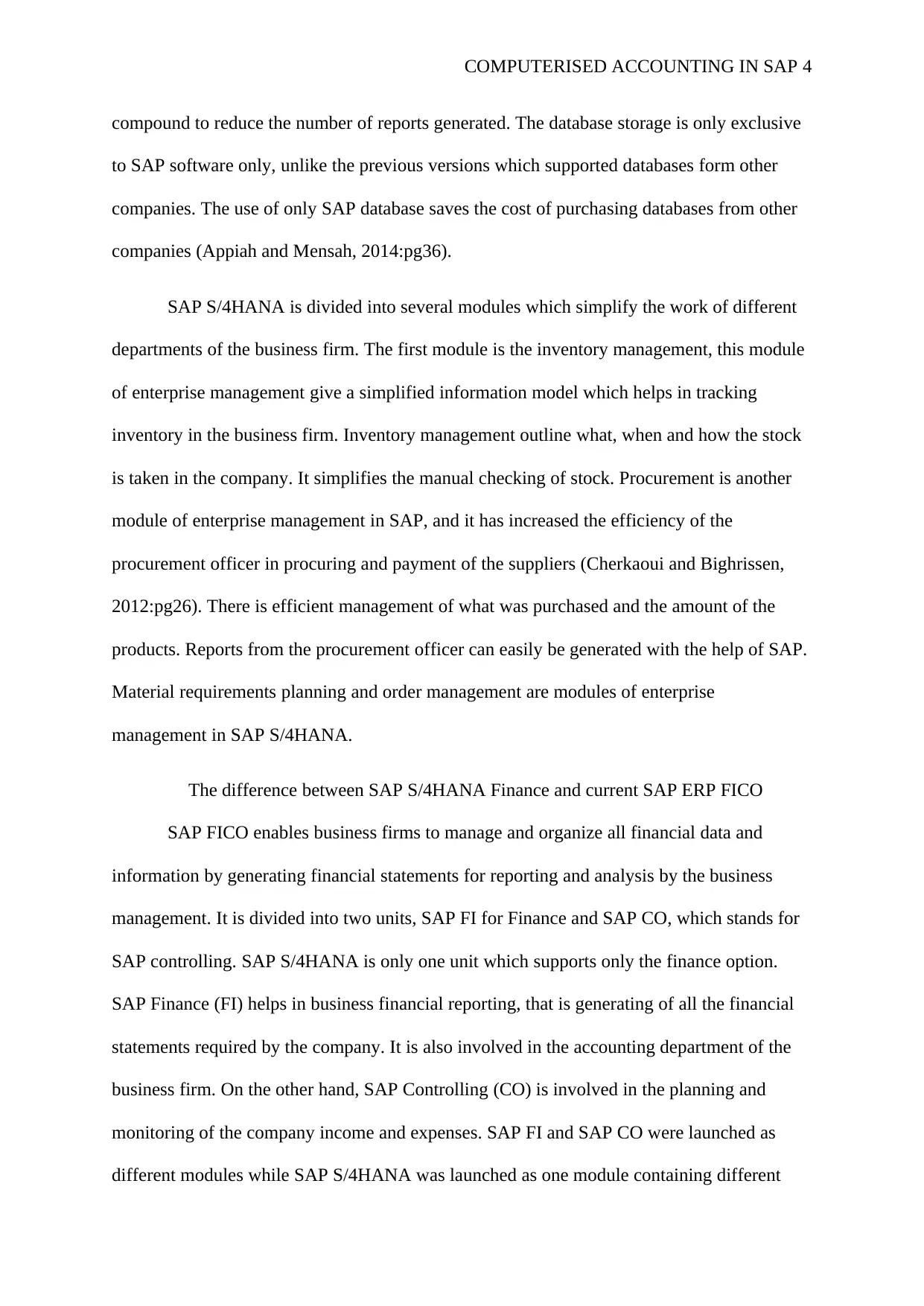
COMPUTERISED ACCOUNTING IN SAP 4
compound to reduce the number of reports generated. The database storage is only exclusive
to SAP software only, unlike the previous versions which supported databases form other
companies. The use of only SAP database saves the cost of purchasing databases from other
companies (Appiah and Mensah, 2014:pg36).
SAP S/4HANA is divided into several modules which simplify the work of different
departments of the business firm. The first module is the inventory management, this module
of enterprise management give a simplified information model which helps in tracking
inventory in the business firm. Inventory management outline what, when and how the stock
is taken in the company. It simplifies the manual checking of stock. Procurement is another
module of enterprise management in SAP, and it has increased the efficiency of the
procurement officer in procuring and payment of the suppliers (Cherkaoui and Bighrissen,
2012:pg26). There is efficient management of what was purchased and the amount of the
products. Reports from the procurement officer can easily be generated with the help of SAP.
Material requirements planning and order management are modules of enterprise
management in SAP S/4HANA.
The difference between SAP S/4HANA Finance and current SAP ERP FICO
SAP FICO enables business firms to manage and organize all financial data and
information by generating financial statements for reporting and analysis by the business
management. It is divided into two units, SAP FI for Finance and SAP CO, which stands for
SAP controlling. SAP S/4HANA is only one unit which supports only the finance option.
SAP Finance (FI) helps in business financial reporting, that is generating of all the financial
statements required by the company. It is also involved in the accounting department of the
business firm. On the other hand, SAP Controlling (CO) is involved in the planning and
monitoring of the company income and expenses. SAP FI and SAP CO were launched as
different modules while SAP S/4HANA was launched as one module containing different
compound to reduce the number of reports generated. The database storage is only exclusive
to SAP software only, unlike the previous versions which supported databases form other
companies. The use of only SAP database saves the cost of purchasing databases from other
companies (Appiah and Mensah, 2014:pg36).
SAP S/4HANA is divided into several modules which simplify the work of different
departments of the business firm. The first module is the inventory management, this module
of enterprise management give a simplified information model which helps in tracking
inventory in the business firm. Inventory management outline what, when and how the stock
is taken in the company. It simplifies the manual checking of stock. Procurement is another
module of enterprise management in SAP, and it has increased the efficiency of the
procurement officer in procuring and payment of the suppliers (Cherkaoui and Bighrissen,
2012:pg26). There is efficient management of what was purchased and the amount of the
products. Reports from the procurement officer can easily be generated with the help of SAP.
Material requirements planning and order management are modules of enterprise
management in SAP S/4HANA.
The difference between SAP S/4HANA Finance and current SAP ERP FICO
SAP FICO enables business firms to manage and organize all financial data and
information by generating financial statements for reporting and analysis by the business
management. It is divided into two units, SAP FI for Finance and SAP CO, which stands for
SAP controlling. SAP S/4HANA is only one unit which supports only the finance option.
SAP Finance (FI) helps in business financial reporting, that is generating of all the financial
statements required by the company. It is also involved in the accounting department of the
business firm. On the other hand, SAP Controlling (CO) is involved in the planning and
monitoring of the company income and expenses. SAP FI and SAP CO were launched as
different modules while SAP S/4HANA was launched as one module containing different
Secure Best Marks with AI Grader
Need help grading? Try our AI Grader for instant feedback on your assignments.
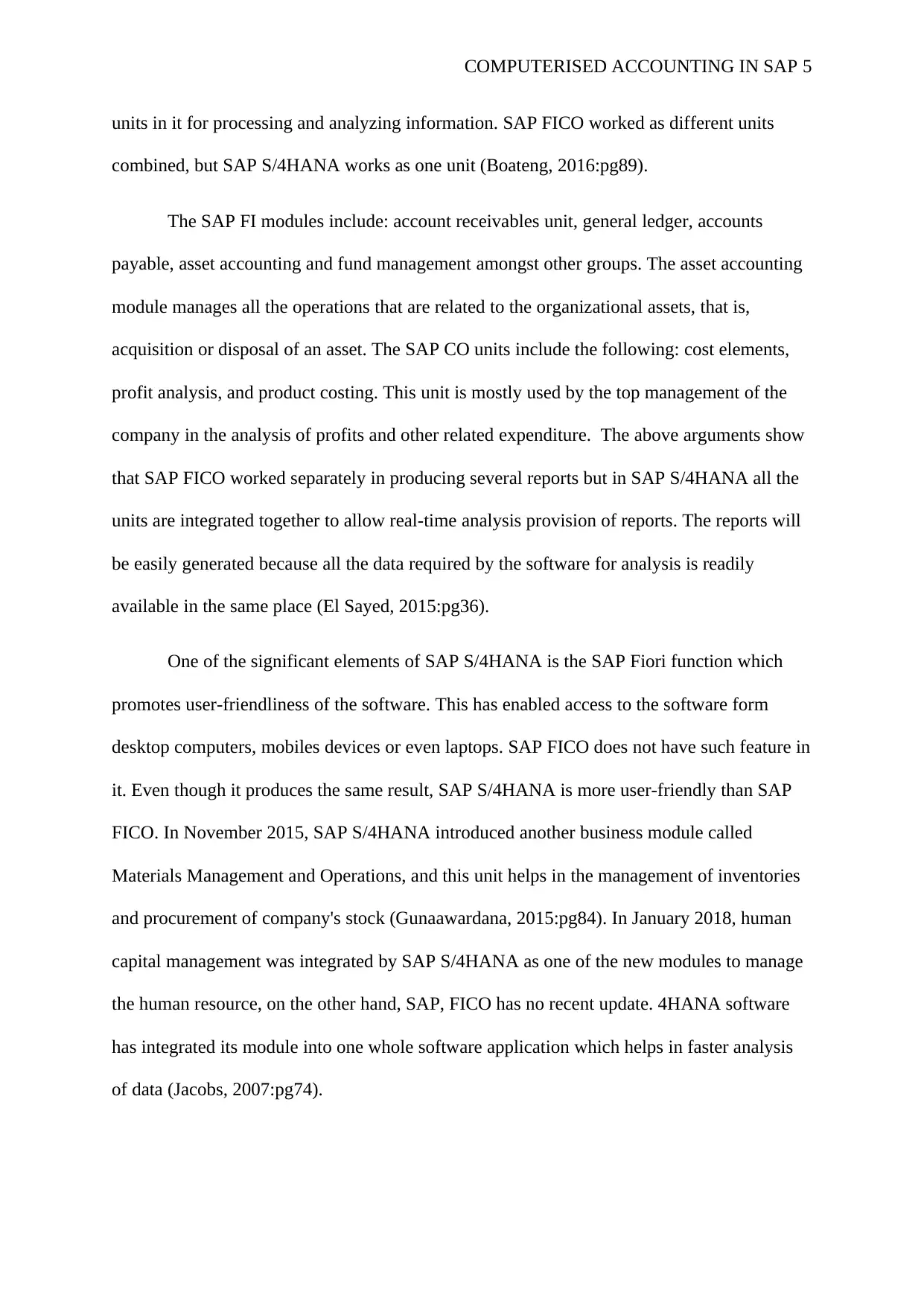
COMPUTERISED ACCOUNTING IN SAP 5
units in it for processing and analyzing information. SAP FICO worked as different units
combined, but SAP S/4HANA works as one unit (Boateng, 2016:pg89).
The SAP FI modules include: account receivables unit, general ledger, accounts
payable, asset accounting and fund management amongst other groups. The asset accounting
module manages all the operations that are related to the organizational assets, that is,
acquisition or disposal of an asset. The SAP CO units include the following: cost elements,
profit analysis, and product costing. This unit is mostly used by the top management of the
company in the analysis of profits and other related expenditure. The above arguments show
that SAP FICO worked separately in producing several reports but in SAP S/4HANA all the
units are integrated together to allow real-time analysis provision of reports. The reports will
be easily generated because all the data required by the software for analysis is readily
available in the same place (El Sayed, 2015:pg36).
One of the significant elements of SAP S/4HANA is the SAP Fiori function which
promotes user-friendliness of the software. This has enabled access to the software form
desktop computers, mobiles devices or even laptops. SAP FICO does not have such feature in
it. Even though it produces the same result, SAP S/4HANA is more user-friendly than SAP
FICO. In November 2015, SAP S/4HANA introduced another business module called
Materials Management and Operations, and this unit helps in the management of inventories
and procurement of company's stock (Gunaawardana, 2015:pg84). In January 2018, human
capital management was integrated by SAP S/4HANA as one of the new modules to manage
the human resource, on the other hand, SAP, FICO has no recent update. 4HANA software
has integrated its module into one whole software application which helps in faster analysis
of data (Jacobs, 2007:pg74).
units in it for processing and analyzing information. SAP FICO worked as different units
combined, but SAP S/4HANA works as one unit (Boateng, 2016:pg89).
The SAP FI modules include: account receivables unit, general ledger, accounts
payable, asset accounting and fund management amongst other groups. The asset accounting
module manages all the operations that are related to the organizational assets, that is,
acquisition or disposal of an asset. The SAP CO units include the following: cost elements,
profit analysis, and product costing. This unit is mostly used by the top management of the
company in the analysis of profits and other related expenditure. The above arguments show
that SAP FICO worked separately in producing several reports but in SAP S/4HANA all the
units are integrated together to allow real-time analysis provision of reports. The reports will
be easily generated because all the data required by the software for analysis is readily
available in the same place (El Sayed, 2015:pg36).
One of the significant elements of SAP S/4HANA is the SAP Fiori function which
promotes user-friendliness of the software. This has enabled access to the software form
desktop computers, mobiles devices or even laptops. SAP FICO does not have such feature in
it. Even though it produces the same result, SAP S/4HANA is more user-friendly than SAP
FICO. In November 2015, SAP S/4HANA introduced another business module called
Materials Management and Operations, and this unit helps in the management of inventories
and procurement of company's stock (Gunaawardana, 2015:pg84). In January 2018, human
capital management was integrated by SAP S/4HANA as one of the new modules to manage
the human resource, on the other hand, SAP, FICO has no recent update. 4HANA software
has integrated its module into one whole software application which helps in faster analysis
of data (Jacobs, 2007:pg74).
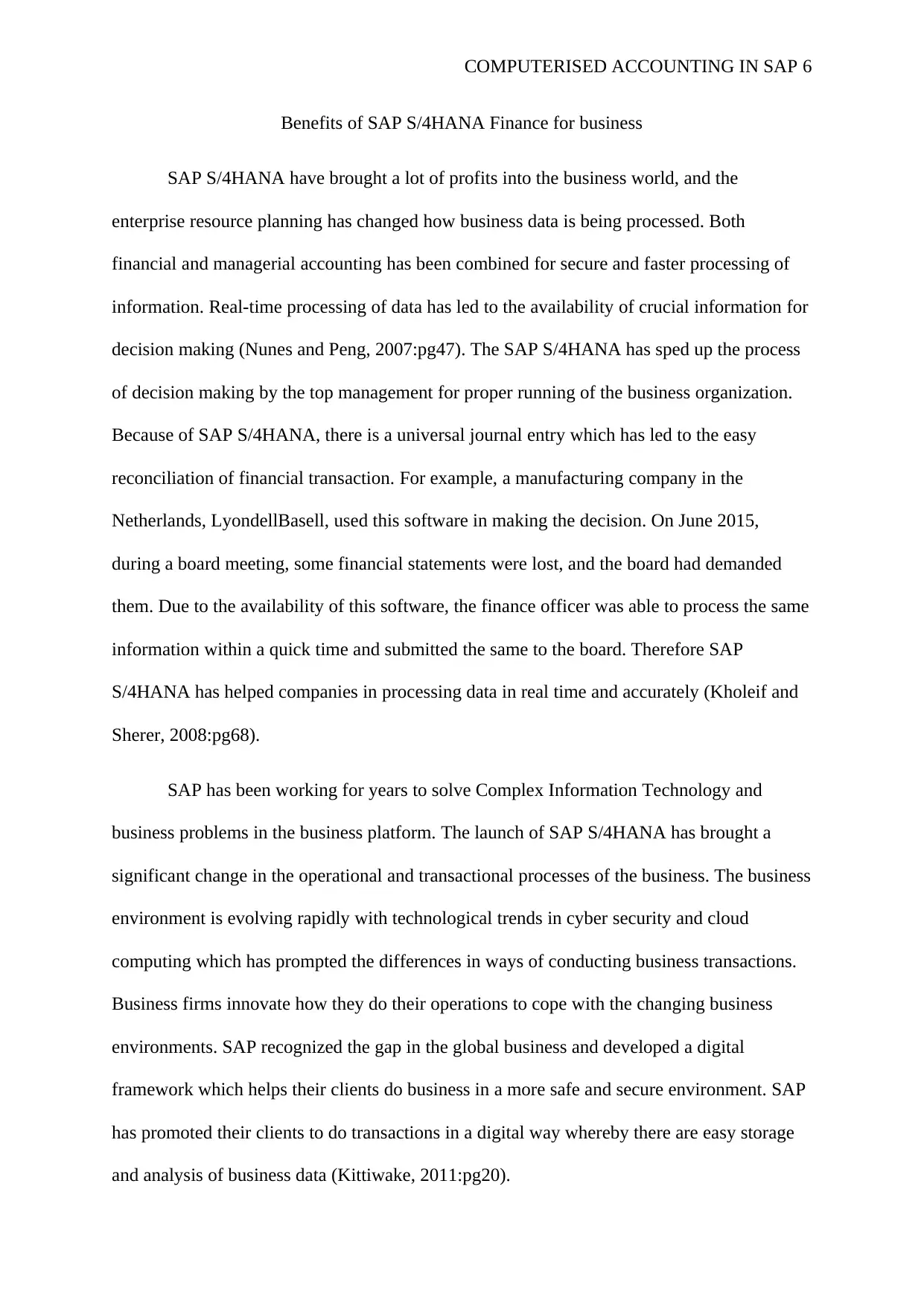
COMPUTERISED ACCOUNTING IN SAP 6
Benefits of SAP S/4HANA Finance for business
SAP S/4HANA have brought a lot of profits into the business world, and the
enterprise resource planning has changed how business data is being processed. Both
financial and managerial accounting has been combined for secure and faster processing of
information. Real-time processing of data has led to the availability of crucial information for
decision making (Nunes and Peng, 2007:pg47). The SAP S/4HANA has sped up the process
of decision making by the top management for proper running of the business organization.
Because of SAP S/4HANA, there is a universal journal entry which has led to the easy
reconciliation of financial transaction. For example, a manufacturing company in the
Netherlands, LyondellBasell, used this software in making the decision. On June 2015,
during a board meeting, some financial statements were lost, and the board had demanded
them. Due to the availability of this software, the finance officer was able to process the same
information within a quick time and submitted the same to the board. Therefore SAP
S/4HANA has helped companies in processing data in real time and accurately (Kholeif and
Sherer, 2008:pg68).
SAP has been working for years to solve Complex Information Technology and
business problems in the business platform. The launch of SAP S/4HANA has brought a
significant change in the operational and transactional processes of the business. The business
environment is evolving rapidly with technological trends in cyber security and cloud
computing which has prompted the differences in ways of conducting business transactions.
Business firms innovate how they do their operations to cope with the changing business
environments. SAP recognized the gap in the global business and developed a digital
framework which helps their clients do business in a more safe and secure environment. SAP
has promoted their clients to do transactions in a digital way whereby there are easy storage
and analysis of business data (Kittiwake, 2011:pg20).
Benefits of SAP S/4HANA Finance for business
SAP S/4HANA have brought a lot of profits into the business world, and the
enterprise resource planning has changed how business data is being processed. Both
financial and managerial accounting has been combined for secure and faster processing of
information. Real-time processing of data has led to the availability of crucial information for
decision making (Nunes and Peng, 2007:pg47). The SAP S/4HANA has sped up the process
of decision making by the top management for proper running of the business organization.
Because of SAP S/4HANA, there is a universal journal entry which has led to the easy
reconciliation of financial transaction. For example, a manufacturing company in the
Netherlands, LyondellBasell, used this software in making the decision. On June 2015,
during a board meeting, some financial statements were lost, and the board had demanded
them. Due to the availability of this software, the finance officer was able to process the same
information within a quick time and submitted the same to the board. Therefore SAP
S/4HANA has helped companies in processing data in real time and accurately (Kholeif and
Sherer, 2008:pg68).
SAP has been working for years to solve Complex Information Technology and
business problems in the business platform. The launch of SAP S/4HANA has brought a
significant change in the operational and transactional processes of the business. The business
environment is evolving rapidly with technological trends in cyber security and cloud
computing which has prompted the differences in ways of conducting business transactions.
Business firms innovate how they do their operations to cope with the changing business
environments. SAP recognized the gap in the global business and developed a digital
framework which helps their clients do business in a more safe and secure environment. SAP
has promoted their clients to do transactions in a digital way whereby there are easy storage
and analysis of business data (Kittiwake, 2011:pg20).

COMPUTERISED ACCOUNTING IN SAP 7
Efficient reporting is another benefit of using SAP S/4HANA. The accuracy of the
financial report is one of the most critical parts of the business. The database table has all the
data that allows the software to compute and provide accurate reports in real-time. There is
no data replication because it is being processed in real-time and therefore there is no
requirement for batch processing. Due to the accuracy and availability of financial reports,
the business can enjoy faster financial closing. The closing of financial; periods, e.g.,
Annually, semi-annually, quarterly or even monthly, it has been made easy, and the finance
officer can close the period with ease. Statement of comprehensive income and that of the
financial position that is required in decision making is readily available (Mabert and
Venkataramanan, 2003:pg63).
The use of asset accounting module efficiently manages Acquisition, depreciation,
and disposal of assets without the confusion of the company day to day business. Liquidity
management component has replaced the cash management. A business firm can manage
short-term cash positions and ensures that there is no or little theft of company’s cash. In the
recent year, most companies lost a lot of cash due to theft by the employees, but with SAP
S/4HANA all the liquid can be traced to the person who withdrew the money. This software
promotes faster tracking of the money; hence there is no loss for the business (Mayere and
Bazet, 2008:pg53). Ego pharmaceutical company in Australia lost millions of dollars before
integrating SAP S/4HANA. The employees were able to sell the drugs for their benefit
without the company's knowledge. They used the back door in selling the stock because the
company was not in a position to trace their share. When SAP S/4HANA was applied in the
management of the financial sector in the company, there were no losses experienced since
then. Inventory management has helped the company trace their stock without losses.
The flexibility of SAP S/4HANA in the business world is a significant improvement
in the company's system. Finance officer can get the financial reports faster without the
Efficient reporting is another benefit of using SAP S/4HANA. The accuracy of the
financial report is one of the most critical parts of the business. The database table has all the
data that allows the software to compute and provide accurate reports in real-time. There is
no data replication because it is being processed in real-time and therefore there is no
requirement for batch processing. Due to the accuracy and availability of financial reports,
the business can enjoy faster financial closing. The closing of financial; periods, e.g.,
Annually, semi-annually, quarterly or even monthly, it has been made easy, and the finance
officer can close the period with ease. Statement of comprehensive income and that of the
financial position that is required in decision making is readily available (Mabert and
Venkataramanan, 2003:pg63).
The use of asset accounting module efficiently manages Acquisition, depreciation,
and disposal of assets without the confusion of the company day to day business. Liquidity
management component has replaced the cash management. A business firm can manage
short-term cash positions and ensures that there is no or little theft of company’s cash. In the
recent year, most companies lost a lot of cash due to theft by the employees, but with SAP
S/4HANA all the liquid can be traced to the person who withdrew the money. This software
promotes faster tracking of the money; hence there is no loss for the business (Mayere and
Bazet, 2008:pg53). Ego pharmaceutical company in Australia lost millions of dollars before
integrating SAP S/4HANA. The employees were able to sell the drugs for their benefit
without the company's knowledge. They used the back door in selling the stock because the
company was not in a position to trace their share. When SAP S/4HANA was applied in the
management of the financial sector in the company, there were no losses experienced since
then. Inventory management has helped the company trace their stock without losses.
The flexibility of SAP S/4HANA in the business world is a significant improvement
in the company's system. Finance officer can get the financial reports faster without the
Paraphrase This Document
Need a fresh take? Get an instant paraphrase of this document with our AI Paraphraser
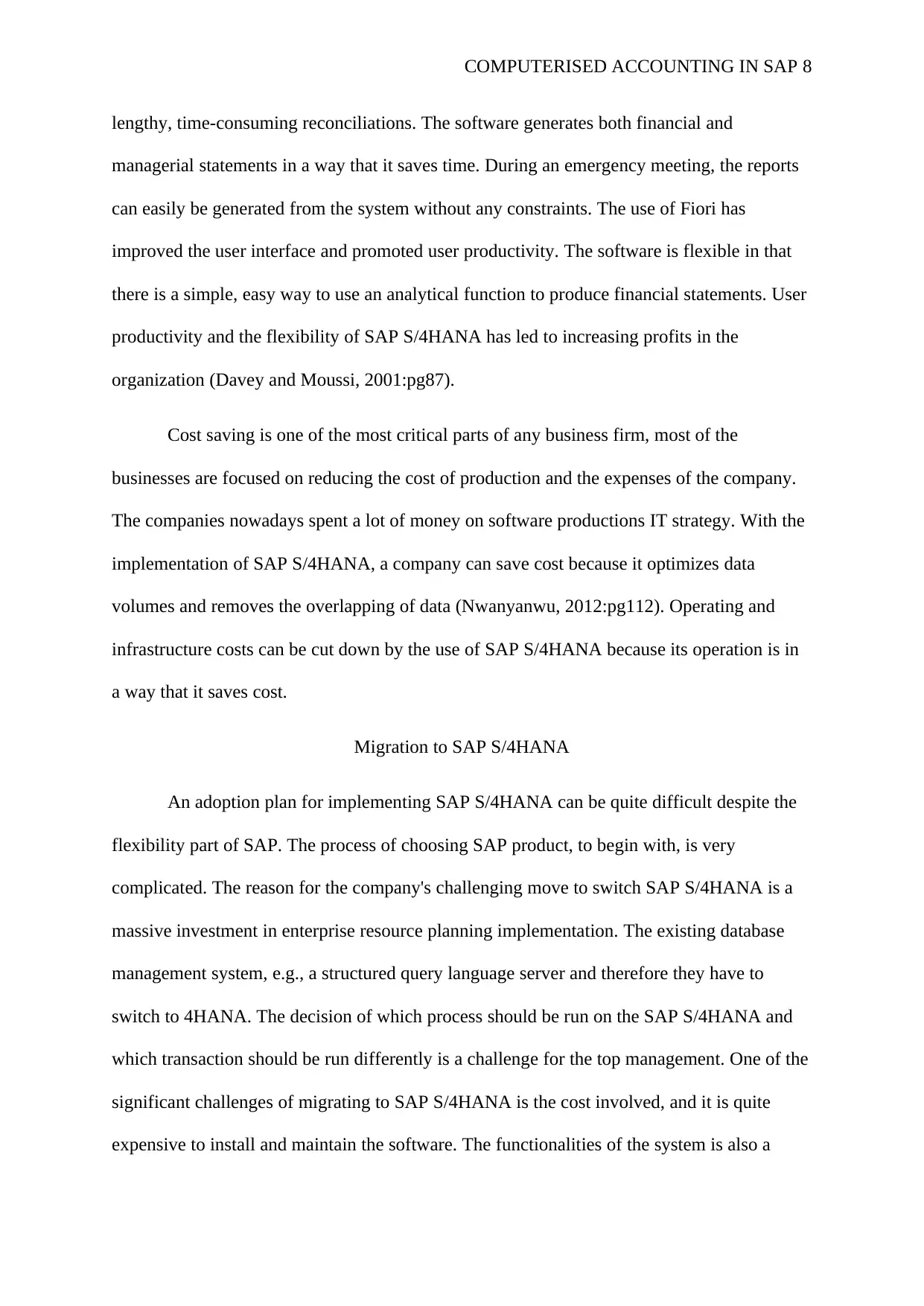
COMPUTERISED ACCOUNTING IN SAP 8
lengthy, time-consuming reconciliations. The software generates both financial and
managerial statements in a way that it saves time. During an emergency meeting, the reports
can easily be generated from the system without any constraints. The use of Fiori has
improved the user interface and promoted user productivity. The software is flexible in that
there is a simple, easy way to use an analytical function to produce financial statements. User
productivity and the flexibility of SAP S/4HANA has led to increasing profits in the
organization (Davey and Moussi, 2001:pg87).
Cost saving is one of the most critical parts of any business firm, most of the
businesses are focused on reducing the cost of production and the expenses of the company.
The companies nowadays spent a lot of money on software productions IT strategy. With the
implementation of SAP S/4HANA, a company can save cost because it optimizes data
volumes and removes the overlapping of data (Nwanyanwu, 2012:pg112). Operating and
infrastructure costs can be cut down by the use of SAP S/4HANA because its operation is in
a way that it saves cost.
Migration to SAP S/4HANA
An adoption plan for implementing SAP S/4HANA can be quite difficult despite the
flexibility part of SAP. The process of choosing SAP product, to begin with, is very
complicated. The reason for the company's challenging move to switch SAP S/4HANA is a
massive investment in enterprise resource planning implementation. The existing database
management system, e.g., a structured query language server and therefore they have to
switch to 4HANA. The decision of which process should be run on the SAP S/4HANA and
which transaction should be run differently is a challenge for the top management. One of the
significant challenges of migrating to SAP S/4HANA is the cost involved, and it is quite
expensive to install and maintain the software. The functionalities of the system is also a
lengthy, time-consuming reconciliations. The software generates both financial and
managerial statements in a way that it saves time. During an emergency meeting, the reports
can easily be generated from the system without any constraints. The use of Fiori has
improved the user interface and promoted user productivity. The software is flexible in that
there is a simple, easy way to use an analytical function to produce financial statements. User
productivity and the flexibility of SAP S/4HANA has led to increasing profits in the
organization (Davey and Moussi, 2001:pg87).
Cost saving is one of the most critical parts of any business firm, most of the
businesses are focused on reducing the cost of production and the expenses of the company.
The companies nowadays spent a lot of money on software productions IT strategy. With the
implementation of SAP S/4HANA, a company can save cost because it optimizes data
volumes and removes the overlapping of data (Nwanyanwu, 2012:pg112). Operating and
infrastructure costs can be cut down by the use of SAP S/4HANA because its operation is in
a way that it saves cost.
Migration to SAP S/4HANA
An adoption plan for implementing SAP S/4HANA can be quite difficult despite the
flexibility part of SAP. The process of choosing SAP product, to begin with, is very
complicated. The reason for the company's challenging move to switch SAP S/4HANA is a
massive investment in enterprise resource planning implementation. The existing database
management system, e.g., a structured query language server and therefore they have to
switch to 4HANA. The decision of which process should be run on the SAP S/4HANA and
which transaction should be run differently is a challenge for the top management. One of the
significant challenges of migrating to SAP S/4HANA is the cost involved, and it is quite
expensive to install and maintain the software. The functionalities of the system is also a
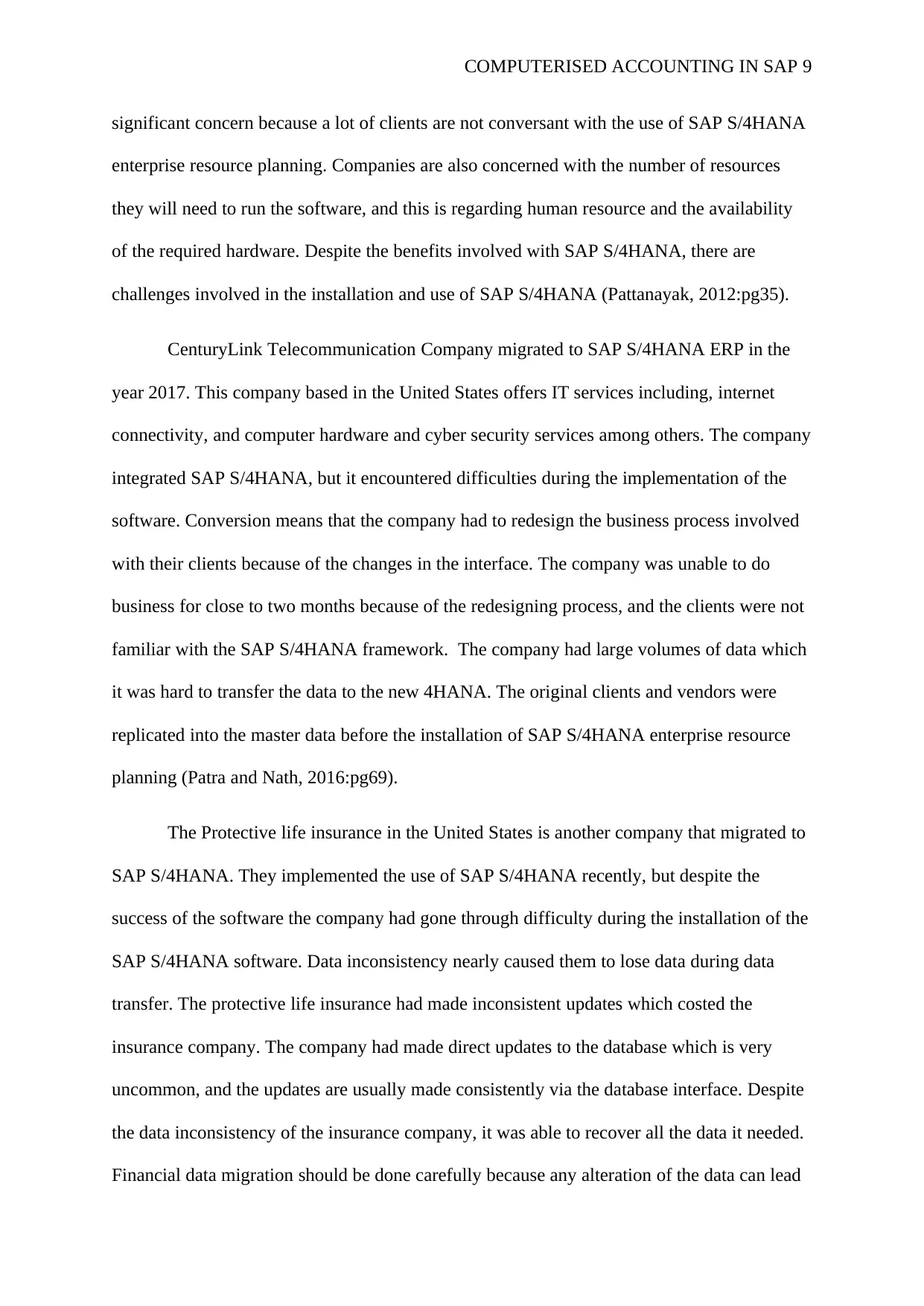
COMPUTERISED ACCOUNTING IN SAP 9
significant concern because a lot of clients are not conversant with the use of SAP S/4HANA
enterprise resource planning. Companies are also concerned with the number of resources
they will need to run the software, and this is regarding human resource and the availability
of the required hardware. Despite the benefits involved with SAP S/4HANA, there are
challenges involved in the installation and use of SAP S/4HANA (Pattanayak, 2012:pg35).
CenturyLink Telecommunication Company migrated to SAP S/4HANA ERP in the
year 2017. This company based in the United States offers IT services including, internet
connectivity, and computer hardware and cyber security services among others. The company
integrated SAP S/4HANA, but it encountered difficulties during the implementation of the
software. Conversion means that the company had to redesign the business process involved
with their clients because of the changes in the interface. The company was unable to do
business for close to two months because of the redesigning process, and the clients were not
familiar with the SAP S/4HANA framework. The company had large volumes of data which
it was hard to transfer the data to the new 4HANA. The original clients and vendors were
replicated into the master data before the installation of SAP S/4HANA enterprise resource
planning (Patra and Nath, 2016:pg69).
The Protective life insurance in the United States is another company that migrated to
SAP S/4HANA. They implemented the use of SAP S/4HANA recently, but despite the
success of the software the company had gone through difficulty during the installation of the
SAP S/4HANA software. Data inconsistency nearly caused them to lose data during data
transfer. The protective life insurance had made inconsistent updates which costed the
insurance company. The company had made direct updates to the database which is very
uncommon, and the updates are usually made consistently via the database interface. Despite
the data inconsistency of the insurance company, it was able to recover all the data it needed.
Financial data migration should be done carefully because any alteration of the data can lead
significant concern because a lot of clients are not conversant with the use of SAP S/4HANA
enterprise resource planning. Companies are also concerned with the number of resources
they will need to run the software, and this is regarding human resource and the availability
of the required hardware. Despite the benefits involved with SAP S/4HANA, there are
challenges involved in the installation and use of SAP S/4HANA (Pattanayak, 2012:pg35).
CenturyLink Telecommunication Company migrated to SAP S/4HANA ERP in the
year 2017. This company based in the United States offers IT services including, internet
connectivity, and computer hardware and cyber security services among others. The company
integrated SAP S/4HANA, but it encountered difficulties during the implementation of the
software. Conversion means that the company had to redesign the business process involved
with their clients because of the changes in the interface. The company was unable to do
business for close to two months because of the redesigning process, and the clients were not
familiar with the SAP S/4HANA framework. The company had large volumes of data which
it was hard to transfer the data to the new 4HANA. The original clients and vendors were
replicated into the master data before the installation of SAP S/4HANA enterprise resource
planning (Patra and Nath, 2016:pg69).
The Protective life insurance in the United States is another company that migrated to
SAP S/4HANA. They implemented the use of SAP S/4HANA recently, but despite the
success of the software the company had gone through difficulty during the installation of the
SAP S/4HANA software. Data inconsistency nearly caused them to lose data during data
transfer. The protective life insurance had made inconsistent updates which costed the
insurance company. The company had made direct updates to the database which is very
uncommon, and the updates are usually made consistently via the database interface. Despite
the data inconsistency of the insurance company, it was able to recover all the data it needed.
Financial data migration should be done carefully because any alteration of the data can lead
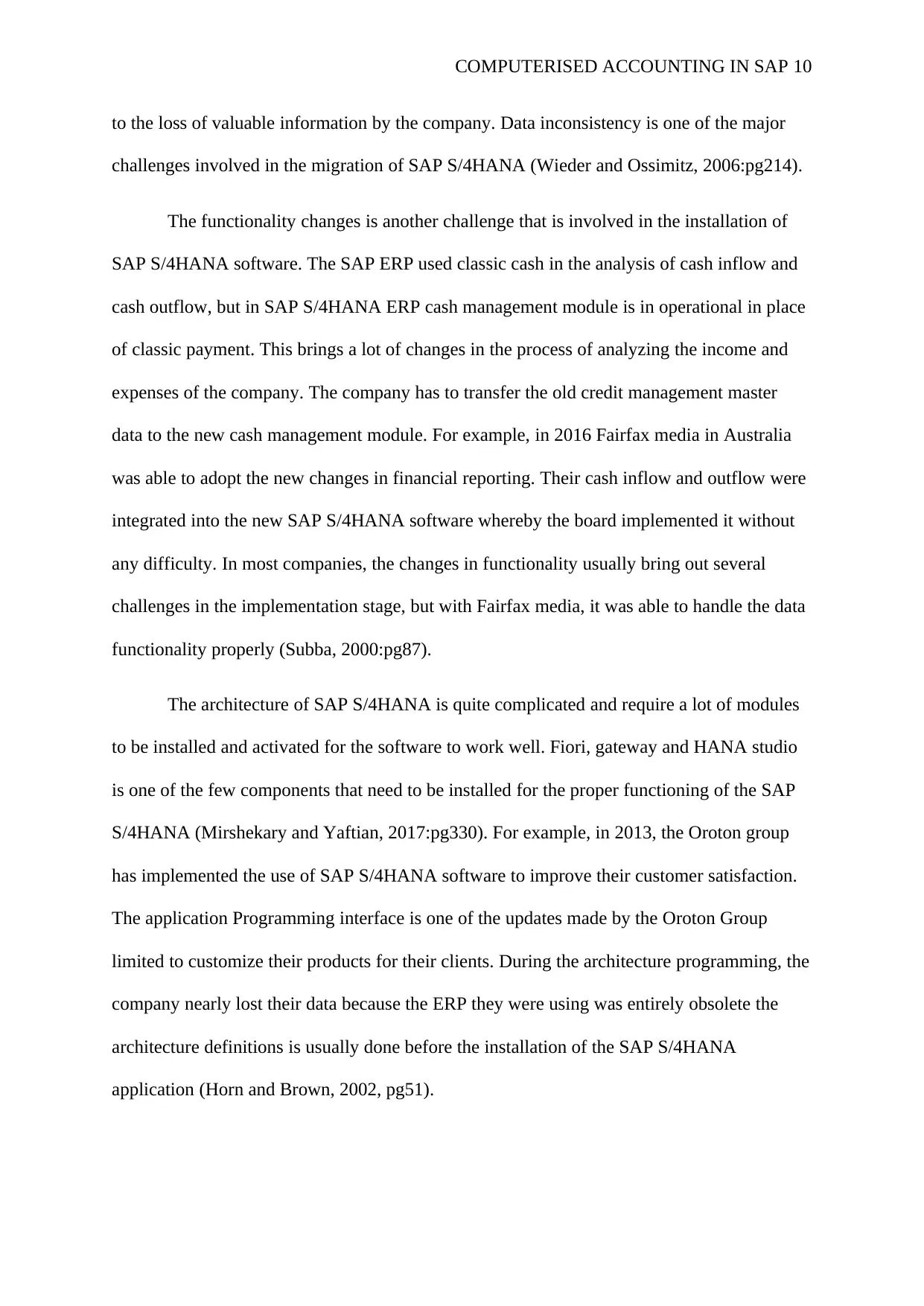
COMPUTERISED ACCOUNTING IN SAP 10
to the loss of valuable information by the company. Data inconsistency is one of the major
challenges involved in the migration of SAP S/4HANA (Wieder and Ossimitz, 2006:pg214).
The functionality changes is another challenge that is involved in the installation of
SAP S/4HANA software. The SAP ERP used classic cash in the analysis of cash inflow and
cash outflow, but in SAP S/4HANA ERP cash management module is in operational in place
of classic payment. This brings a lot of changes in the process of analyzing the income and
expenses of the company. The company has to transfer the old credit management master
data to the new cash management module. For example, in 2016 Fairfax media in Australia
was able to adopt the new changes in financial reporting. Their cash inflow and outflow were
integrated into the new SAP S/4HANA software whereby the board implemented it without
any difficulty. In most companies, the changes in functionality usually bring out several
challenges in the implementation stage, but with Fairfax media, it was able to handle the data
functionality properly (Subba, 2000:pg87).
The architecture of SAP S/4HANA is quite complicated and require a lot of modules
to be installed and activated for the software to work well. Fiori, gateway and HANA studio
is one of the few components that need to be installed for the proper functioning of the SAP
S/4HANA (Mirshekary and Yaftian, 2017:pg330). For example, in 2013, the Oroton group
has implemented the use of SAP S/4HANA software to improve their customer satisfaction.
The application Programming interface is one of the updates made by the Oroton Group
limited to customize their products for their clients. During the architecture programming, the
company nearly lost their data because the ERP they were using was entirely obsolete the
architecture definitions is usually done before the installation of the SAP S/4HANA
application (Horn and Brown, 2002, pg51).
to the loss of valuable information by the company. Data inconsistency is one of the major
challenges involved in the migration of SAP S/4HANA (Wieder and Ossimitz, 2006:pg214).
The functionality changes is another challenge that is involved in the installation of
SAP S/4HANA software. The SAP ERP used classic cash in the analysis of cash inflow and
cash outflow, but in SAP S/4HANA ERP cash management module is in operational in place
of classic payment. This brings a lot of changes in the process of analyzing the income and
expenses of the company. The company has to transfer the old credit management master
data to the new cash management module. For example, in 2016 Fairfax media in Australia
was able to adopt the new changes in financial reporting. Their cash inflow and outflow were
integrated into the new SAP S/4HANA software whereby the board implemented it without
any difficulty. In most companies, the changes in functionality usually bring out several
challenges in the implementation stage, but with Fairfax media, it was able to handle the data
functionality properly (Subba, 2000:pg87).
The architecture of SAP S/4HANA is quite complicated and require a lot of modules
to be installed and activated for the software to work well. Fiori, gateway and HANA studio
is one of the few components that need to be installed for the proper functioning of the SAP
S/4HANA (Mirshekary and Yaftian, 2017:pg330). For example, in 2013, the Oroton group
has implemented the use of SAP S/4HANA software to improve their customer satisfaction.
The application Programming interface is one of the updates made by the Oroton Group
limited to customize their products for their clients. During the architecture programming, the
company nearly lost their data because the ERP they were using was entirely obsolete the
architecture definitions is usually done before the installation of the SAP S/4HANA
application (Horn and Brown, 2002, pg51).
Secure Best Marks with AI Grader
Need help grading? Try our AI Grader for instant feedback on your assignments.

COMPUTERISED ACCOUNTING IN SAP 11
Conclusion
In conclusion, computerized accounting is a fundamental requirement in the global
business transactions. The companies that have adopted the use of SAP S/4HANA in doing
their day to day business transaction have an added advantage over their competitors. Faster
forecasting and planning, quick report analysis, real-time analysis are amongst the benefits of
SAP S/4HANA software. However, data inconsistency during data transfer is some of the
challenges associated with the implementation of SAP S/4HANA. The problems can be
avoided by promoting a careful transfer of data and preventing unrequired updates of the
software. The integrity of the data can be checked by keeping the master database without
any alteration of data. For a company to become a successful digital business, a proper data
management strategy needs to be installed to provide a competitive advantage over their
rivals. The architecture of SAP S/4HANA has many modules and components that allow
real-time generation of financial reports with efficiency and accuracy.
Conclusion
In conclusion, computerized accounting is a fundamental requirement in the global
business transactions. The companies that have adopted the use of SAP S/4HANA in doing
their day to day business transaction have an added advantage over their competitors. Faster
forecasting and planning, quick report analysis, real-time analysis are amongst the benefits of
SAP S/4HANA software. However, data inconsistency during data transfer is some of the
challenges associated with the implementation of SAP S/4HANA. The problems can be
avoided by promoting a careful transfer of data and preventing unrequired updates of the
software. The integrity of the data can be checked by keeping the master database without
any alteration of data. For a company to become a successful digital business, a proper data
management strategy needs to be installed to provide a competitive advantage over their
rivals. The architecture of SAP S/4HANA has many modules and components that allow
real-time generation of financial reports with efficiency and accuracy.
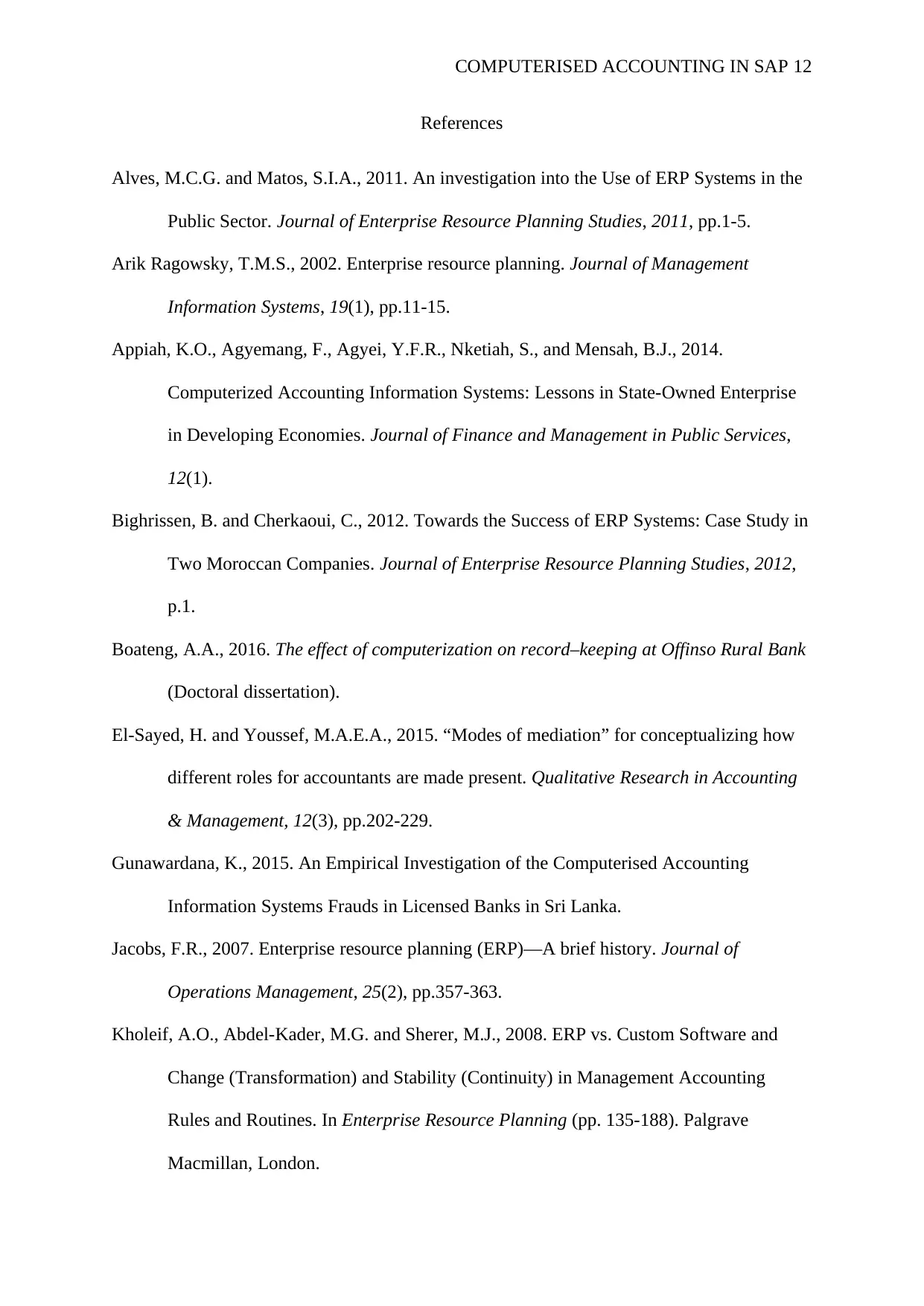
COMPUTERISED ACCOUNTING IN SAP 12
References
Alves, M.C.G. and Matos, S.I.A., 2011. An investigation into the Use of ERP Systems in the
Public Sector. Journal of Enterprise Resource Planning Studies, 2011, pp.1-5.
Arik Ragowsky, T.M.S., 2002. Enterprise resource planning. Journal of Management
Information Systems, 19(1), pp.11-15.
Appiah, K.O., Agyemang, F., Agyei, Y.F.R., Nketiah, S., and Mensah, B.J., 2014.
Computerized Accounting Information Systems: Lessons in State-Owned Enterprise
in Developing Economies. Journal of Finance and Management in Public Services,
12(1).
Bighrissen, B. and Cherkaoui, C., 2012. Towards the Success of ERP Systems: Case Study in
Two Moroccan Companies. Journal of Enterprise Resource Planning Studies, 2012,
p.1.
Boateng, A.A., 2016. The effect of computerization on record–keeping at Offinso Rural Bank
(Doctoral dissertation).
El-Sayed, H. and Youssef, M.A.E.A., 2015. “Modes of mediation” for conceptualizing how
different roles for accountants are made present. Qualitative Research in Accounting
& Management, 12(3), pp.202-229.
Gunawardana, K., 2015. An Empirical Investigation of the Computerised Accounting
Information Systems Frauds in Licensed Banks in Sri Lanka.
Jacobs, F.R., 2007. Enterprise resource planning (ERP)—A brief history. Journal of
Operations Management, 25(2), pp.357-363.
Kholeif, A.O., Abdel-Kader, M.G. and Sherer, M.J., 2008. ERP vs. Custom Software and
Change (Transformation) and Stability (Continuity) in Management Accounting
Rules and Routines. In Enterprise Resource Planning (pp. 135-188). Palgrave
Macmillan, London.
References
Alves, M.C.G. and Matos, S.I.A., 2011. An investigation into the Use of ERP Systems in the
Public Sector. Journal of Enterprise Resource Planning Studies, 2011, pp.1-5.
Arik Ragowsky, T.M.S., 2002. Enterprise resource planning. Journal of Management
Information Systems, 19(1), pp.11-15.
Appiah, K.O., Agyemang, F., Agyei, Y.F.R., Nketiah, S., and Mensah, B.J., 2014.
Computerized Accounting Information Systems: Lessons in State-Owned Enterprise
in Developing Economies. Journal of Finance and Management in Public Services,
12(1).
Bighrissen, B. and Cherkaoui, C., 2012. Towards the Success of ERP Systems: Case Study in
Two Moroccan Companies. Journal of Enterprise Resource Planning Studies, 2012,
p.1.
Boateng, A.A., 2016. The effect of computerization on record–keeping at Offinso Rural Bank
(Doctoral dissertation).
El-Sayed, H. and Youssef, M.A.E.A., 2015. “Modes of mediation” for conceptualizing how
different roles for accountants are made present. Qualitative Research in Accounting
& Management, 12(3), pp.202-229.
Gunawardana, K., 2015. An Empirical Investigation of the Computerised Accounting
Information Systems Frauds in Licensed Banks in Sri Lanka.
Jacobs, F.R., 2007. Enterprise resource planning (ERP)—A brief history. Journal of
Operations Management, 25(2), pp.357-363.
Kholeif, A.O., Abdel-Kader, M.G. and Sherer, M.J., 2008. ERP vs. Custom Software and
Change (Transformation) and Stability (Continuity) in Management Accounting
Rules and Routines. In Enterprise Resource Planning (pp. 135-188). Palgrave
Macmillan, London.
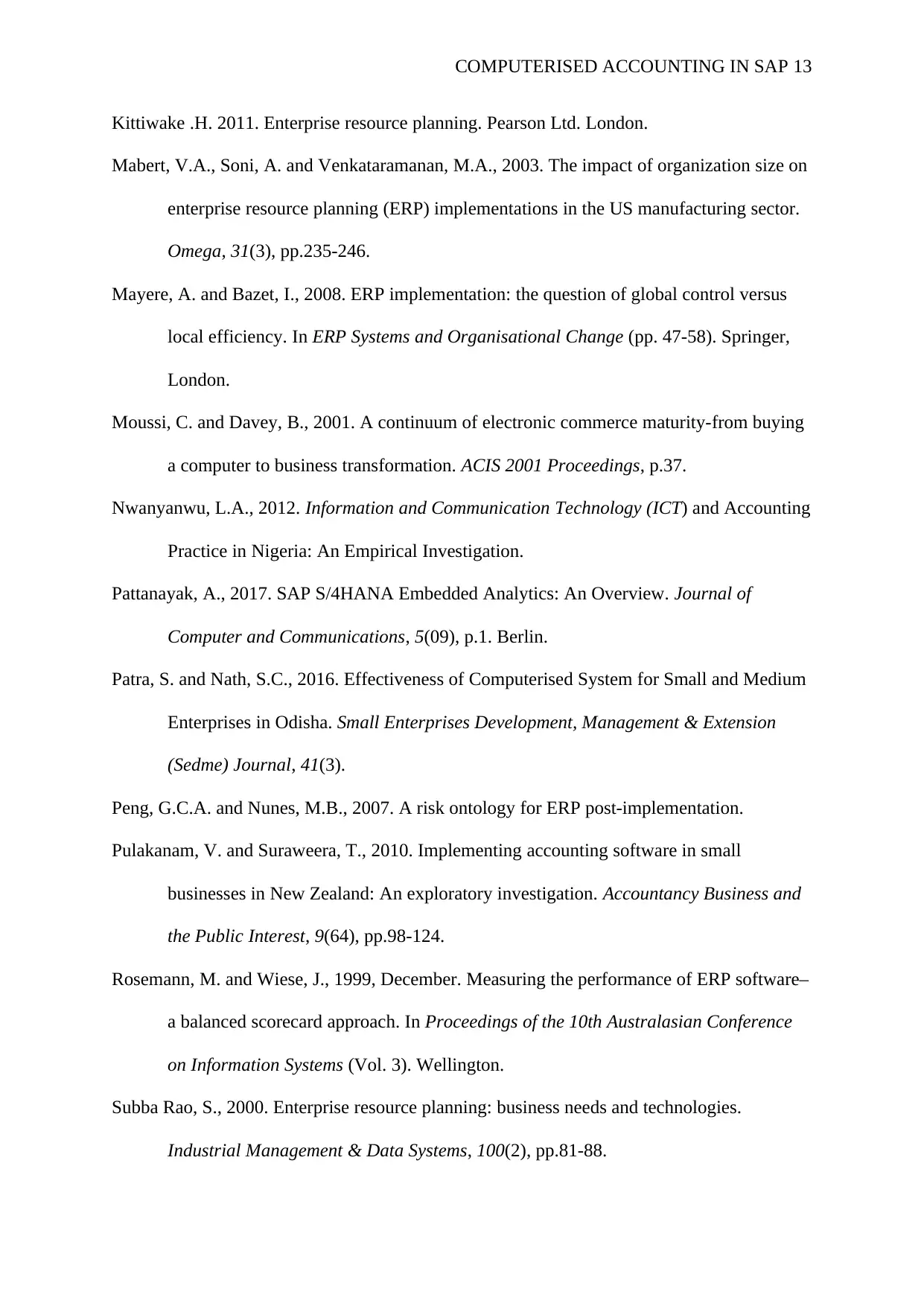
COMPUTERISED ACCOUNTING IN SAP 13
Kittiwake .H. 2011. Enterprise resource planning. Pearson Ltd. London.
Mabert, V.A., Soni, A. and Venkataramanan, M.A., 2003. The impact of organization size on
enterprise resource planning (ERP) implementations in the US manufacturing sector.
Omega, 31(3), pp.235-246.
Mayere, A. and Bazet, I., 2008. ERP implementation: the question of global control versus
local efficiency. In ERP Systems and Organisational Change (pp. 47-58). Springer,
London.
Moussi, C. and Davey, B., 2001. A continuum of electronic commerce maturity-from buying
a computer to business transformation. ACIS 2001 Proceedings, p.37.
Nwanyanwu, L.A., 2012. Information and Communication Technology (ICT) and Accounting
Practice in Nigeria: An Empirical Investigation.
Pattanayak, A., 2017. SAP S/4HANA Embedded Analytics: An Overview. Journal of
Computer and Communications, 5(09), p.1. Berlin.
Patra, S. and Nath, S.C., 2016. Effectiveness of Computerised System for Small and Medium
Enterprises in Odisha. Small Enterprises Development, Management & Extension
(Sedme) Journal, 41(3).
Peng, G.C.A. and Nunes, M.B., 2007. A risk ontology for ERP post-implementation.
Pulakanam, V. and Suraweera, T., 2010. Implementing accounting software in small
businesses in New Zealand: An exploratory investigation. Accountancy Business and
the Public Interest, 9(64), pp.98-124.
Rosemann, M. and Wiese, J., 1999, December. Measuring the performance of ERP software–
a balanced scorecard approach. In Proceedings of the 10th Australasian Conference
on Information Systems (Vol. 3). Wellington.
Subba Rao, S., 2000. Enterprise resource planning: business needs and technologies.
Industrial Management & Data Systems, 100(2), pp.81-88.
Kittiwake .H. 2011. Enterprise resource planning. Pearson Ltd. London.
Mabert, V.A., Soni, A. and Venkataramanan, M.A., 2003. The impact of organization size on
enterprise resource planning (ERP) implementations in the US manufacturing sector.
Omega, 31(3), pp.235-246.
Mayere, A. and Bazet, I., 2008. ERP implementation: the question of global control versus
local efficiency. In ERP Systems and Organisational Change (pp. 47-58). Springer,
London.
Moussi, C. and Davey, B., 2001. A continuum of electronic commerce maturity-from buying
a computer to business transformation. ACIS 2001 Proceedings, p.37.
Nwanyanwu, L.A., 2012. Information and Communication Technology (ICT) and Accounting
Practice in Nigeria: An Empirical Investigation.
Pattanayak, A., 2017. SAP S/4HANA Embedded Analytics: An Overview. Journal of
Computer and Communications, 5(09), p.1. Berlin.
Patra, S. and Nath, S.C., 2016. Effectiveness of Computerised System for Small and Medium
Enterprises in Odisha. Small Enterprises Development, Management & Extension
(Sedme) Journal, 41(3).
Peng, G.C.A. and Nunes, M.B., 2007. A risk ontology for ERP post-implementation.
Pulakanam, V. and Suraweera, T., 2010. Implementing accounting software in small
businesses in New Zealand: An exploratory investigation. Accountancy Business and
the Public Interest, 9(64), pp.98-124.
Rosemann, M. and Wiese, J., 1999, December. Measuring the performance of ERP software–
a balanced scorecard approach. In Proceedings of the 10th Australasian Conference
on Information Systems (Vol. 3). Wellington.
Subba Rao, S., 2000. Enterprise resource planning: business needs and technologies.
Industrial Management & Data Systems, 100(2), pp.81-88.
Paraphrase This Document
Need a fresh take? Get an instant paraphrase of this document with our AI Paraphraser
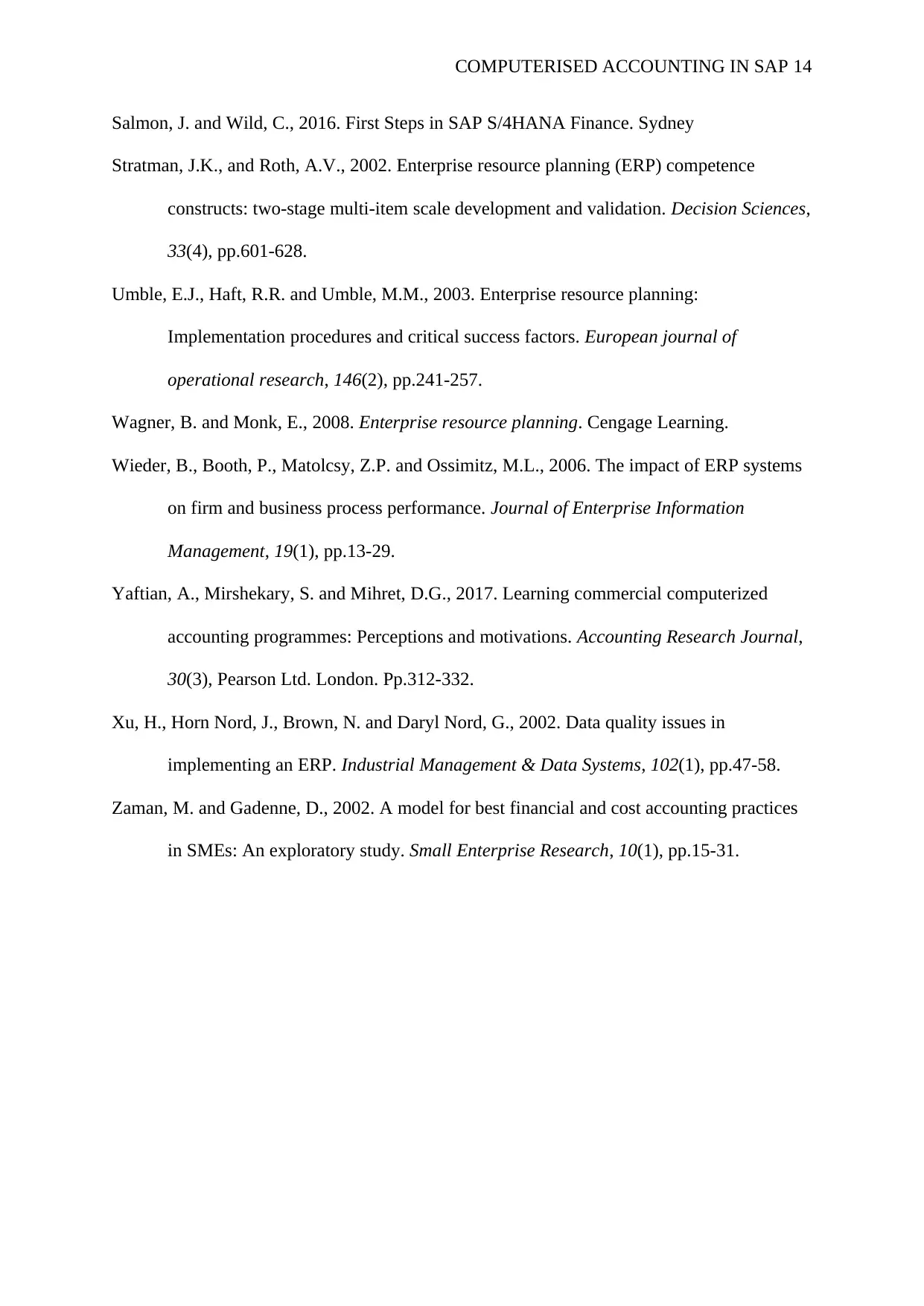
COMPUTERISED ACCOUNTING IN SAP 14
Salmon, J. and Wild, C., 2016. First Steps in SAP S/4HANA Finance. Sydney
Stratman, J.K., and Roth, A.V., 2002. Enterprise resource planning (ERP) competence
constructs: two‐stage multi‐item scale development and validation. Decision Sciences,
33(4), pp.601-628.
Umble, E.J., Haft, R.R. and Umble, M.M., 2003. Enterprise resource planning:
Implementation procedures and critical success factors. European journal of
operational research, 146(2), pp.241-257.
Wagner, B. and Monk, E., 2008. Enterprise resource planning. Cengage Learning.
Wieder, B., Booth, P., Matolcsy, Z.P. and Ossimitz, M.L., 2006. The impact of ERP systems
on firm and business process performance. Journal of Enterprise Information
Management, 19(1), pp.13-29.
Yaftian, A., Mirshekary, S. and Mihret, D.G., 2017. Learning commercial computerized
accounting programmes: Perceptions and motivations. Accounting Research Journal,
30(3), Pearson Ltd. London. Pp.312-332.
Xu, H., Horn Nord, J., Brown, N. and Daryl Nord, G., 2002. Data quality issues in
implementing an ERP. Industrial Management & Data Systems, 102(1), pp.47-58.
Zaman, M. and Gadenne, D., 2002. A model for best financial and cost accounting practices
in SMEs: An exploratory study. Small Enterprise Research, 10(1), pp.15-31.
Salmon, J. and Wild, C., 2016. First Steps in SAP S/4HANA Finance. Sydney
Stratman, J.K., and Roth, A.V., 2002. Enterprise resource planning (ERP) competence
constructs: two‐stage multi‐item scale development and validation. Decision Sciences,
33(4), pp.601-628.
Umble, E.J., Haft, R.R. and Umble, M.M., 2003. Enterprise resource planning:
Implementation procedures and critical success factors. European journal of
operational research, 146(2), pp.241-257.
Wagner, B. and Monk, E., 2008. Enterprise resource planning. Cengage Learning.
Wieder, B., Booth, P., Matolcsy, Z.P. and Ossimitz, M.L., 2006. The impact of ERP systems
on firm and business process performance. Journal of Enterprise Information
Management, 19(1), pp.13-29.
Yaftian, A., Mirshekary, S. and Mihret, D.G., 2017. Learning commercial computerized
accounting programmes: Perceptions and motivations. Accounting Research Journal,
30(3), Pearson Ltd. London. Pp.312-332.
Xu, H., Horn Nord, J., Brown, N. and Daryl Nord, G., 2002. Data quality issues in
implementing an ERP. Industrial Management & Data Systems, 102(1), pp.47-58.
Zaman, M. and Gadenne, D., 2002. A model for best financial and cost accounting practices
in SMEs: An exploratory study. Small Enterprise Research, 10(1), pp.15-31.
1 out of 14
Related Documents
Your All-in-One AI-Powered Toolkit for Academic Success.
+13062052269
info@desklib.com
Available 24*7 on WhatsApp / Email
![[object Object]](/_next/static/media/star-bottom.7253800d.svg)
Unlock your academic potential
© 2024 | Zucol Services PVT LTD | All rights reserved.




